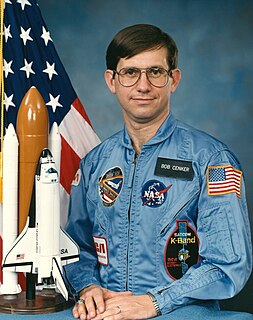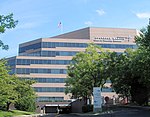Related Research Articles

Titan was a family of United States expendable rockets used between 1959 and 2005. Titan I and Titan II were part of the US Air Force's intercontinental ballistic missile fleet until 1987. The space launch vehicle versions contributed the majority of the 368 Titan launches, including all the Project Gemini crewed flights of the mid-1960s. Titan vehicles were also used to lift US military payloads as well as civilian agency intelligence-gathering satellites and to send highly successful interplanetary scientific probes throughout the Solar System.

Vandenberg Air Force Base is a United States Air Force Base located 9.2 miles (14.8 km) northwest of Lompoc, California. The installation falls under the jurisdiction of the 30th Space Wing, United States Space Force (USSF).

The Corona program was a series of American strategic reconnaissance satellites produced and operated by the Central Intelligence Agency Directorate of Science & Technology with substantial assistance from the U.S. Air Force. The Corona satellites were used for photographic surveillance of the Soviet Union (USSR), the People's Republic of China, and other areas beginning in June 1959 and ending in May 1972.

The RM-81 Agena was an American rocket upper stage and satellite bus which was developed by Lockheed initially for the canceled WS-117L reconnaissance satellite program. Following the split-up of WS-117L into SAMOS and Corona for image intelligence, and MIDAS for early warning, the Agena was later used as an upper stage, and an integrated component, for several programs, including Corona reconnaissance satellites and the Agena Target Vehicle used to demonstrate rendezvous and docking during Project Gemini. It was used as an upper stage on the Atlas, Thor, Thorad and Titan IIIB rockets, and considered for others including the Space Shuttle and Atlas V. A total of 365 Agena rockets were launched between February 28, 1959 and February 1987. Only 33 Agenas carried NASA payloads and the vast majority were for DoD programs.

Cape Canaveral Air Force Station (CCAFS) is an installation of the United States Space Force's 45th Space Wing.
The Martin Marietta Corporation was an American company founded in 1961 through the merger of Glenn L. Martin Company and American-Marietta Corporation. The combined company became a leader in chemicals, aerospace, and electronics. In 1995, it merged with Lockheed Corporation to form Lockheed Martin.

Robert Joseph "Bob" Cenker is an American aerospace and electrical engineer, aerospace systems consultant, and former astronaut. Cenker worked for 18 years at RCA Astro-Electronics, and its successor company GE Astro Space, on a variety of spacecraft projects. He spent most of his career working on commercial communications satellites, including the Satcom, Spacenet and GStar programs.

BYEMAN codenamed LANYARD, the KH-6 was the unsuccessful first attempt to develop and deploy a very high-resolution optical reconnaissance satellite by the United States National Reconnaissance Office. Launches and launch attempts spanned the period from March to July 1963. The project was quickly put together to get imagery of a site near Leningrad suspected of having anti-ballistic missiles. The satellite carried Itek's "E-5" camera developed for the SAMOS program, which had been cancelled. The camera had a focal length of 1.67 m (66 in) and could discern objects on the ground 1.8 m (6 ft) in size. The ground swath of the camera was 14 x 74 km. The satellite weighed 1,500 kg, and had a single re-entry vehicle in which exposed film was returned to earth for a mid-air aircraft recovery. The KH-6 was manufactured by Lockheed Martin and launched from Vandenberg Air Force Base on Thor-Agena D rockets.

BYEMAN codenamed GAMBIT, the KH-7 was a reconnaissance satellite used by the United States from July 1963 to June 1967. Like the older CORONA system, it acquired imagery intelligence by taking photographs and returning the undeveloped film to earth. It achieved a typical ground-resolution of 2 ft (0.61 m) to 3 ft (0.91 m). Though most of the imagery from the KH-7 satellites was declassified in 2002, details of the satellite program remained classified until 2011.

The SAMOS or SAMOS-E program was a relatively short-lived series of reconnaissance satellites for the United States in the early 1960s, also used as a cover for the initial development of the KH-7 GAMBIT system. Reconnaissance was performed with film cameras and television surveillance from polar low Earth orbits with film canister returns and transmittals over the United States. SAMOS was first launched in 1960 from Vandenberg Air Force Base.

Titan IIIB was the collective name for a number of derivatives of the Titan II ICBM and Titan III launch vehicle, modified by the addition of an Agena upper stage. It consisted of four separate rockets. The Titan 23B was a basic Titan II with an Agena upper stage, and the Titan 24B was the same concept, but using the slightly enlarged Titan IIIM rocket as the base. The Titan 33B was a Titan 23B with the Agena enclosed in an enlarged fairing, in order to allow larger payloads to be launched. The final member of the Titan IIIB family was the Titan 34B which was a Titan 24B with the larger fairing used on the Titan 33B.

Space Launch Complex 3 (SLC-3) is a launch site at Vandenberg Air Force Base that consists of two separate launch pads. SLC-3E (East) is currently used by the Atlas V launch vehicle, while SLC-3W (West) has been demolished.

The Atlas-Agena was an American expendable launch system derived from the SM-65 Atlas missile. It was a member of the Atlas family of rockets, and was launched 109 times between 1960 and 1978. It was used to launch the first five Mariner uncrewed probes to the planets Venus and Mars, and the Ranger and Lunar Orbiter uncrewed probes to the Moon. The upper stage was also used as an uncrewed orbital target vehicle for the Gemini crewed spacecraft to practice rendezvous and docking. However, the launch vehicle family was originally developed for the Air Force and most of its launches were classified DoD payloads.

Atlas is a family of US missiles and space launch vehicles that originated with the SM-65 Atlas. The Atlas intercontinental ballistic missile (ICBM) program was initiated in the late 1950s under the Convair Division of General Dynamics. Atlas was a liquid propellant rocket burning RP-1 fuel with liquid oxygen in three engines configured in an unusual "stage-and-a-half" or "parallel staging" design: two outboard booster engines were jettisoned along with supporting structures during ascent, while the center sustainer engine, propellant tanks and other structural elements remained connected through propellant depletion and engine shutdown.

Thor was a US space launch vehicle derived from the PGM-17 Thor intermediate-range ballistic missile. The Thor rocket was the first member of the Delta rocket family of space launch vehicles. The last launch of a direct derivative of the Thor missile occurred in 2018 as the first stage of the final Delta II.

The Missile Defense Alarm System, or MIDAS, was an United States Air Force Air Defense Command system of 12 early-warning satellites that provided limited notice of Soviet intercontinental ballistic missile launches between 1960 and 1966. Originally intended to serve as a complete early-warning system working in conjunction with the Ballistic Missile Early Warning System, cost and reliability concerns limited the project to a research and development role. Three of the system's 12 launches ended in failure, and the remaining nine satellites provided crude infrared early-warning coverage of the Soviet Union until the project was replaced by the Defense Support Program. MiDAS represented one element of the United States's first generation of reconnaissance satellites that also included the Corona and SAMOS series. Though MIDAS failed in its primary role as a system of infrared early-warning satellites, it pioneered the technologies needed in successor systems.
A balloon tank is a style of propellant tank used in the SM-65 Atlas intercontinental ballistic missile (ICBM) and Centaur upper stage that does not use an internal framework, but instead relies on a positive internal pressurization to keep its shape.
The Atlas SLV-3, or SLV-3 Atlas was an American expendable launch system derived from the SM-65 Atlas / SM-65D Atlas missile. It was a member of the Atlas family of rockets.

The 6555th Aerospace Test Group is an inactive United States Air Force unit. It was last assigned to the Eastern Space and Missile Center and stationed at Patrick AFB, Florida. It was inactivated on 1 October 1990.

The ascent propulsion system (APS) or lunar module ascent engine (LMAE) is a fixed-thrust hypergolic rocket engine developed by Bell Aerosystems for use in the Apollo lunar module ascent stage. It used Aerozine 50 fuel, and N
2O
4 oxidizer. Rocketdyne provided the injector system, at the request of NASA, when Bell could not solve combustion instability problems.
References
- ↑ "Lockheed Martin To Slash 1,200 Jobs At Space Systems Unit". RTTNews. 2011-06-14. Retrieved 2015-05-13.
- ↑ "Cassini Mission Overview" (PDF). NASA. Archived from the original (PDF) on 10 June 2011. Retrieved 17 June 2011.
- ↑ "The Television Infrared Observation Satellite Program (TIROS)". Science.nasa.gov. NASA. Retrieved 3 March 2017.
- 1 2 3 Michelson, Daniel; Cleary, Kenneth (7 April 2017). "RCA Astro-Electronics Division records" (PDF). dla.library.upenn.edu. Univ of Penn. p. 4 (Biography/History). Archived (PDF) from the original on 17 February 2018. Retrieved 16 February 2018.
After GE acquired RCA in 1986, it combined AED with the Spacecraft Operations of its Space Systems Division to form the GE Astro Space Division. The entire division was sold to Martin Marietta in 1993, which in turn merged with Lockheed to form Lockheed Martin in 1995. Soon after the merger, Lockheed Martin announced that they would be closing the former AED facility. In 1998, forty years after its establishment, the RCA Space Center shut down for good.
- ↑ "Biographical Data: ROBERT J. CENKER". jsc.nasa.gov. NASA. Retrieved 13 February 2017.
- ↑ "Training Photo: S85-44834 (20 Nov. 1985)". Spaceflight.nasa.gov. NASA. Retrieved 20 May 2017.
- ↑ "SATCOM KU-1". nssdc.gsfc.nasa.gov. Retrieved 13 February 2017.
- ↑ "STS-61C Press Kit: DECEMBER 1985" (PDF). jsc.nasa.gov. NASA. Retrieved 13 February 2017.
- ↑ "61-C (24)". Science.ksc.nasa.gov. NASA. Retrieved 20 February 2017.
- ↑ "ROBERT J. CENKER: AEROSPACE SYSTEMS CONSULTANT". NASA.gov. NASA. Archived from the original on 23 October 2012. Retrieved 25 February 2017.
- ↑ "Mission Archives: STS-26". NASA.gov. NASA. Retrieved 19 February 2017.
- ↑ "NASA - STS-51L Mission Profile". NASA.gov. NASA. Retrieved 20 February 2017.
- ↑ "STS-35 (38)". Science.ksc.nasa.gov. NASA. Retrieved 20 February 2017.
- 1 2 3 4 "Encyclopedia Astronautica: East Windsor". Astronautix.com. Retrieved 3 March 2017.
- ↑ "Increasing Navy Support: Lockheed Martin to Expand Cape Canaveral Workforce by 2017". lockheedmartin.com.
